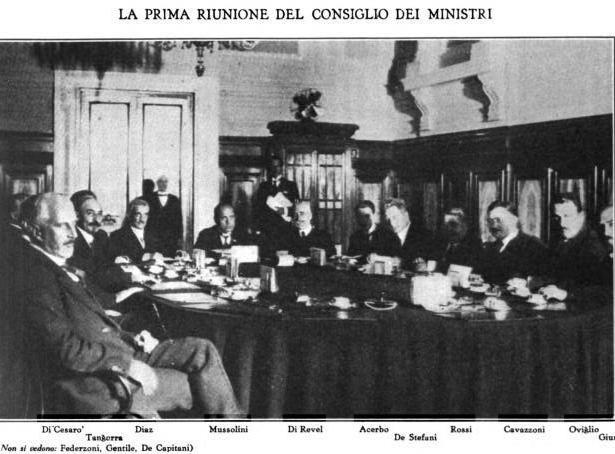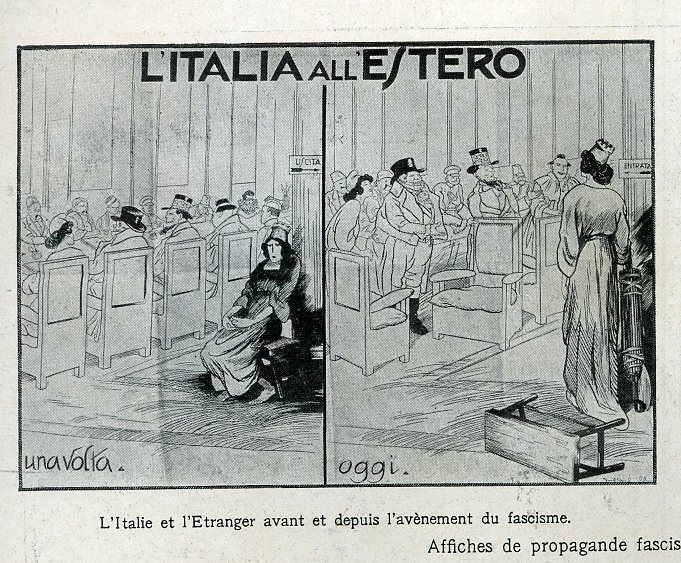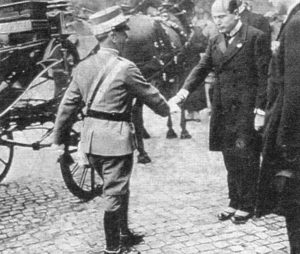Mussolini created a structure of economic and social governing in which the government — on behalf of the fascist party — declares itself to be a superclass “power of national solidarity”.
Editor’s note: The migrant crisis creates a new Europe. Right-wing parties already win elections – like in Switzerland. The success of more radical, extreme right wing is a matter of time and pressure caused by the refugees on the European countries, which number keeps growing. However, once Europeans believe in the solutions proposed by right wing and ultra-right parties and let them into the government, there will be no way of getting them out. Their methods never change – violence and political terror. They will never leave the power, once they get it. Unfortunately, there is no strong resistance from the inside Europe that could stop them once they are in power. Moreover, any resistance will be suppress by the ultra-right. In XXI century, the cost that the world would pay for buying into what new right politicians promise Europe, would be dramatically higher than the one world paid in XX century. We need to search for solution! We need a new answer to the most dangerous challenge of the XXI century.
The fascist coup d’etat in Italy concluded with a triumphant march of fascist cohorts along the streets of Rome as they were leaving the city. Mussolini announced the members of the new Cabinet of Ministers — not only fascists, but also popolare, democrats and liberals — on November 30, 1922. Mussolini left the Interior and Foreign Ministries to himself.
He declared during the first sitting of the Parliament: “I don’t want to abuse our victory, I could, but I don’t want to… I could punish everyone who tried to demonize, defame fascism… I have created the coalition government not in order to receive the parliamentary majority — I don’t need it — but in order to call everyone who wants to help — regardless of their party — to save exhausted Italy… But the House must understand that whether Italy will live for two days or two years depends on it… We demand full authority, we want full responsibility. Let nobody of our former, current or future enemies imagine that we have come not for long…“
Mussolini was almost just as rough during his speech in the Senate: “…If perfect liberalism demands to give the freedom to mutilate forty million Italians to several hundred madmen, fanatics or scum — then I am not a liberal… I want national discipline to stop being an empty word… Fascists… are equipped with a mystical feeling of obedience. I am convinced that… fascist illegalism comes to its end these days and will be gone in the near future.“
At that time fascists were finishing off everything that was politically or economically related to “Reds” in the provinces. But, indeed, several days later an order was issued — and was executed — to stop the pogroms.

IV Comintern Congress discussed Italy during these same days. During which Karl Radek said: “I see the victory of Fascism… as the greatest defeat that socialism and communism have suffered since the beginning of this period of world revolution… If… the social-democratic party of Italy will not understand the foundations of this victory of fascism and the reasons of our defeat, we will have to face a long-term domination of fascism.” The Chairman of the Comintern, Grigory Zinovyev, made an even darker prophesy: “…what happened in Italy is not a local event. We will inevitably have to face such events in other countries as well, though, perhaps, in other forms. It is probable that we will not be able to avoid… a period… of fascist coups d’etat all over Central and Middle Europe.“
Meanwhile, Mussolini wasn’t going to depend on the support of his fascists alone. First of all, he quickly “embraced to death” his old rival D’Annunzio. Mussolini knew that prior to the fascist coup d’etat his rival offered his services and the services of his loyal arditi to the king and the Prime Minister in order to secure a “soft” coup d’etat in his favor. After the coup d’etat Mussolini buyed out D’Annunzio’s villa and made the government pay all villa maintenance expenses, bought the poet’s archives as state property, created a national institute to publish the complete works of D’Annunzio, showered his ambitious rival with state awards, had him elected as an Academy member. But didn’t allow him to participate in big-time politics.
At the same time Mussolini improved the relations with Vatican. He met with the representative of the Pope, cardinal Gasparri, and promised to cleanse Italy of communists and masons, introduce harsher sanctions against those who insult the religion, hang crucifixes in schools and courtrooms, reintroduce army chaplains, introduce mandatory religious education in all educational institutions. Soon Mussolini and Gentile, appointed Minister of Public Education, made most of these promises come to life. The school reform brought the crucifix, religion and Latin back to the education system. Masonic lodges and communists were mostly destroyed.
Mussolini’s set the task to the fascist propaganda machine: form the state politics as a radical imperial nationalism, an heir to the Great Rome. And openly recruited elite nationalists to his party who stayed away from fascism before because it was too much “for the people”, had a “socialist” flavor. Mussolini emphasized that it is national-fascism that he was building and declared to the nationalists: “We brought you the numbers, you gave us the doctrine“. Enrico Corradini’s Nationalist Association was merged with the fascist party in March 1923; radical aristocratic nationalist personnel assumed high-level positions in the party hierarchy. Mussolini gave away the most important government positions — Minister of the Interior and Minister of Justice — to the representatives of nationalists, Luigi Federzoni and Massimo Rocca, in summer 1924.
After the “left-wing” was defeated Mussolini repeated on a regular basis that he considers liberalism to be the main enemy of the state and nation. He wrote in spring 1923 in “Hierarchy” magazine: “…Men are tired of liberty… There are other charming words, much more glorious for the excited and stern youth starting their life in the morning twilight of new history. These words are: order, hierarchy, discipline… Fascism is not afraid to be known as reactionary and to declare itself anti-liberal… It had already stepped over and, if this will be necessary, will calmly step over the disfigured, half-rotten corpse of lady Freedom.”
When asked how fascists were going to build New Italy, Mussolini answered that his political platform is self-evident: “…I don’t know a single ideological and political movement which would have been armed with a more solid and wll-defined doctrine. We face unquestionable truths: the state, which must be strong; the government which has to defend itself, for it defends the nation against subversive work; the cooperation of classes, respect towards religion; development of all national energies; this is the doctrine of life.”
This propaganda of fascists — coupled with an actual order that they established in the country — got more and more support of the masses. In November 1923 the Parliament, obedient to Mussolini, adopted the so-called “Acerbo law” which granted two-thirds of seats in the House to the party that won the majority of votes in the elections (but not less than 25% of votes). During the spring 1924 elections fascists (in an alliance with liberals (!)) — became the owners of the House.
Both the common fascist and liberal party list and the support of fascist by the union of largest enterprises “Confindustria” is not a coincidence. Mussolini fully renounced his former “socialistic” ideas of worker control in the factories, nationalization and state interference in the economy. He declared: “The state becomes great only when it refuses to dominate the matter and dominates the spirit.“
Mussolini created a special Ministry of Press and Propaganda in July 1924 in order to “dominate the spirit”, appointing the nationalist Dino Alfieri as Minister. Soon almost all opposition newspapers were banned. Only a member of the fascist party and the fascist trade union of journalists could become the editor-in-chief of a newspaper. Print media, radio, cinema and the system of education (Mussolini’s companion, the philosopher-minister Gentile, was most actively implementing policies in the latter area) became strictly controlled by the fascist functionaries. Mussolini remembered both Pareto’s claim that the government needs the “resource of the consent of the governed” and the lessons of Moska and Le Bon regarding the myths and the suggestion of myths to the masses. And built an all-encompassing system of indoctrination, upbringing and propaganda which transmitted, day and night, the fascist view of how good the political, economic, social and cultural norms of fascism are to the population of Italy and the foreign audience.

In the area of “matter”, that is, economy, Mussolini’s government instantly initiated strict anti-socialist reforms. Denationalization of enterprises was launched, industrial and farming subsidies were cancelled, the limitation on residential rental payment was lifted, old-age insurance was cancelled, respect towards property was strongly preached (all of this — with reference to the ancient Roman tradition). Most of direct taxes are replaced with indirect ones, the progressive scale of direct taxes is replaced with a proportional one, beneficial for the business.
Fascist government openly found new socio-political support among the bourgeoisie — from major to petty, blackmailing it with the “Red threat” and making it shift the economy to a peace-time model at the same time.
Mussolini’s government implemented these policies with a slogan “Economy, labor, discipline”. Approximately 30 thousand state officials resigned in 1923. The work day gradually shifts back from 8 to 9 hours. The goal of achieving a balanced budget was set — and achieved by 1924. The inflation went down, export grew. The trade balance of the country was improved. Five years after the fascist coup d’etat, in the end of 1927, the exchange of paper lira for gold was officially restored. Old and new supporters of fascists quite sincerely said that “Italy is resurrected like Lazarus.“
Only once did the left-wing — sharply weakened by by fascist repressions, but not fully destroyed — receive a real chance to turn the tables. On June 10 1924 fascists murdered a very popular and well-known socialist politician Giacomo Matteotti. This murder caused both a parliamentary and political crisis. Communists had appealed to all parliamentary groups to join a universal strike and issue an ultimatum to the king to dismiss Mussolini’s government. However, the socialist, popolare and democrat parliamentary groups, having declared the organization of an “antifascist front”, simply left the Parliament, creating a kind of a separate legislative house.

Mussolini used the pause to his own advantage. He fired the most radical fascist politicians (including the ones responsible for the murder, as well as most influential competitors of his in the party), and made the fascist militia to swear allegiance to the king. And through newspapers, radio, rallies persistently convinced the monarch, the bourgeoisie, the masses and Vatican that the collapse of his fascist government will inevitably lead to a new round of “socialist chaos”. As a result, the opposition achieved nothing and the political crisis faded away without serious consequences to the fascists.
Next Mussolini persistently fortified his fascist regime — politically, economically, socially. He used syndicalism and corporatism as a primary mechanism.
The ideas of syndicalism and corporatism were quite popular in the social-political way in Italy. Pope Leo XIII had stated in the encyclical (in 1891, pretty much repeating the thesis of Emile Durkheim which we have discussed earlier) that different classes of a complicated society are interdependent and that an interclass, meaning, a national solidarity was necessary. Catholic trade unions/syndicates and Popolare party platform were to a great extent based upon these principles. Structures similar to Middle Age guilds and corporations which had united entrepreneurs and workers of different occupations in solidarity had also remained in Italy.
However, Mussolini understood how unstable such solidarity was. To solve the problem he once again addressed the concept of his favorite Sorel, who though that an organized resistance of workers has to resurrect the industrial activity of the bourgeoisie: “…The growing and well-organized working class can make the capitalistic class remain inspired by the economic struggle…“
Mussolini formally armed himself with this idea of Sorel and advocated it, but in reality he positioned his fascist party over the corporatist system as a “general manager”.
The laws of the “Labor Charter” got adopted in spring-summer 1926. According to these laws lower level syndicate-trade unions were united into professional corporations, separated for workers and entrepreneurs. Corporations (a total of 13, 6 of them for businesses of different branches, 6 for workers of different branches, one for people of independent professions) were established by the decrees of the Minister for Corporations (Mussolini appointed himself as Minister for this position).
The mandatory requirement for recognition of a lower level syndicate — “defending the economic and moral interests” of its members, as well as “national upbringing“. The whole system of the activity of corporations and syndicates (appointing to positions, labor initiatives and so on) was controlled by the fascist party. For this purpose a special “syndicate division” was created in the party.
Mussolini declared in autumn of 1926, after this “corporate reform”: “We are the carriers of a new political system, a new type of civilization. There can be no tyranny where a whole million men join the fascist party, three million men join the economic organizations, 20 million men obeying the directives of the government. If there ever was a democratic regime in history, then it is our fascist system, the true democracy…“
As a result, Mussolini created a structure of economic and social governing in which the government — on behalf of the fascist party — declares itself to be a superclass “power of national solidarity” and, because of this, “an honest judge” of the relationship between the syndicates and corporations, which, supposedly, are the real economic rulers. However, this is how Nikolay Ustryalov, one of the most perceptive contemporaries and analysts of the fascist regime, defined this situation: “Fascist government is not the rule of syndicates, but a rule over syndicates, not only in practice, but also legally. The hierarchy principle does not merge with the corporate principle, but chokes it… The state is the party. The party is the leader. Organic selection, not mechanical elections dominate in the party. It is an ‘elite’, but not a ‘representation of the people’.“
But Mussolini had to secure a strict hierarchy in the fascist party, as well as its rule and firm absolute power in the party for himself in order to create such a system.
That is what he concerned himself with first and foremost.
Source (for copy): https://eu.eot.su/?p=3247
This is the translation of the seventh article (first published in “Essence of Time” newspaper issue 59 on December 18th, 2013) by Yury Byaly of a series on essence, birth and rise of fascism. Part 1: Marxism, imperialism and the justification of inequality. Part 2. Part 3. Part 4. Part 5. Part 6.




